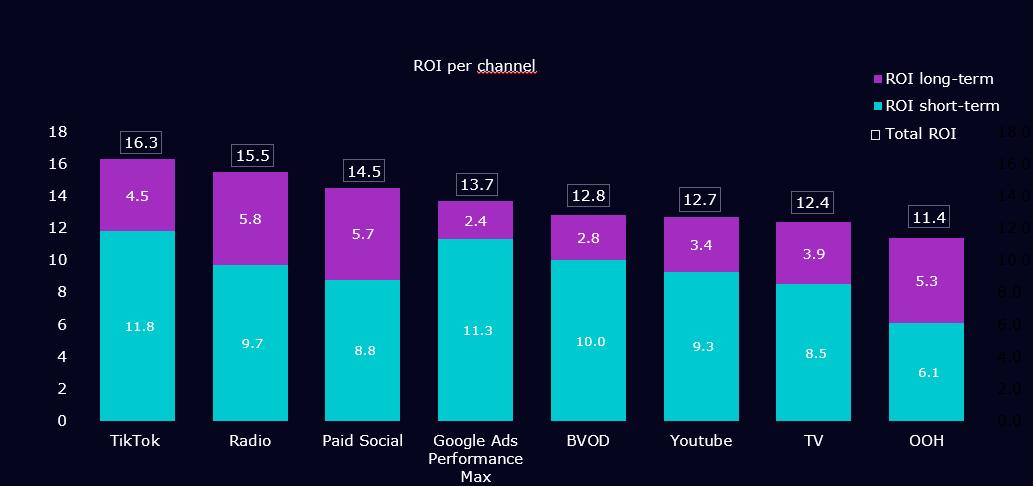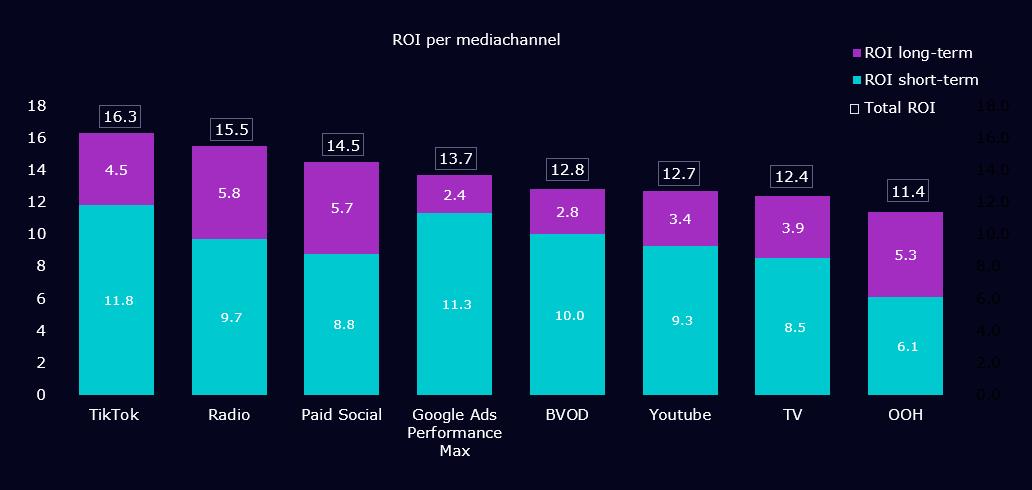




A MARKETING MIX MODELING STUDY BY DENTSU
Sales Modeling, or Marketing Mix Modeling, has long been the preferred approach to capturing the effect of marketing and media investments. However, sales modeling usually only focuses on short term effect. To capture the full impact of marketing, we must also include the long-term brand-driven sales effect. Our approach, developed at dentsu, focuses on measuring both short term and long- term effects from marketing. We call this methodology framework Total Contribution of Marketing
In cooperation with TikTok, we used this framework to focus specifically on measuring the sales effect from advertisements on TikTok in the Nordic markets, Norway, Denmark, Sweden and Finland.
The modeling consists of three different models, which focus on short term as well as long term effects.
The science behind the data
Our modeling suite is comprised of three broad methodologies, arranged in an intuitive hierarchy. Our Marketing Mix Model estimates the direct, short-term effects of media on sales, while controlling for a multitude of confounding factors (macro, weather, seasonality, competition, and so on).
Parameters in most of our MMMs are fitted with the help of an evolutionary algorithm, constrained by what we know about the industry, the client’s vertical, and the general mechanism of persuasion through media.
Our Brand Attribution models attribute long-term brand performance to media investments, trends and confounding factors, using generalized linear models with longer attribution windows and less granularity
The media's effect on revenue
A statistical model that identifies the direct causal relationship between media investment and revenue.
The brand's effect on revenue
A statistical model that builds a bridge between two independent variables, revenue and brand KPIs, to identify the causal relationship and how they affect each other.
The media's effect on brand
A statistical model that identifies the causal relationship between media investment and changes in brand KPIs.
(larger aggregation units) than typical MMMs.
Brand performance KPIs are often composite, constructed using factor analysis from the covariance between brand tracker items in raw data obtained from the surveyor; this maximizes the signal-to-noise ratio in brand performance KPIs, enabling us to highlight media effects on brand, as well as brand effects on sales.
We estimate the latter using a hierarchical linear model (i.e., our Bridge Model) that attributes crosssample variations in base sales to historical variations in brand performance.
By combining results from the three stages, we estimate a total effect of media on sales: its direct effect, as well as its indirect effects, via brand lift.

• TikTok delivered the strongest short-term ROI of all media channels for 11 out of 15 studied brands.
• TikTok is a powerful driver of short-term sales in all four Nordic markets.
• 7 out of 15 studied brands found that TikTok also provides significant long-term ROI.
• Advertisers who used TikTok consistently (always-on), rather than in campaign bursts, saw the greatest sales effects and generally, a higher ROI.
• Most brands are underinvesting on TikTok, meaning ROI would improve with increased spending.


The initial phase of the study focused on measuring the short-term sales effects (1 to 6 weeks) of TikTok advertising. The analysis included 15 brands that had advertised on TikTok over the past 2–3 years, providing a robust dataset for assessing sales performance.
With a short-term ROI of 11.8, TikTok ranks among the most effective media channels for driving immediate sales, according to dentsu benchmark data. In practical terms, this means that advertisers generate nearly 12 times their initial investment in sales revenue within just six weeks establishing TikTok as one of the strongest performance marketing channels available.
• For 75% of the advertisers in the study, TikTok had the highest ROI of all channels.
• All advertisers saw a significant increase in short term sales effects from using TikTok.
• The optimal media mix for short-term effect is a combination of lower-funnel platforms, in addition to TikTok. For example,
• TikTok’s sales effect lasted for 3-4 weeks after the campaign ended
• The advertisers with the best ROI from TikTok, have a continuous presence on the platform.
• Deep dives show that UGC content featuring creators had excellent sales results.
While our study confirms that TikTok delivers both short- and long-term sales effects, it is evident that the platform is most effective when used consistently in an always-on strategy, rather than in isolated bursts or campaign periods. Advertisers who invested in TikTok regularly experienced significantly higher sales impact, which grew with sustained and consistent activity.
There are both quantitative and qualitative benefits to adopting an always-on approach. From a consumer perspective, it’s impossible to predict when someone will enter the consideration phase for your product. Engaging with audiences over time, using varied content, increases the likelihood that your brand will be top of mind when they are ready to purchase.
By applying the insights from our study such as prioritizing engaging storytelling content over tactical, promotion-led approaches advertisers can maximize results quickly
As TikTok is still a relatively new platform, many advertisers remain in a test-and-learn phase. We hope these findings will provide valuable guidance as you continue to explore and refine your TikTok strategy.
Always on as part of the performance marketing strategy
Limited campaign period
Average short-term ROI from all media: 8.7

Average long-term ROI from all media: 3.2


In addition to examining the short-term sales effects of TikTok advertising measured as the impact on sales 1 to 6 weeks after exposure we also sought to capture the platform’s longterm effects.
Long-term effects were assessed by analyzing how media exposure influences brand metrics (measured using brand tracker data) and how these improvements translate into sales over time. For the purposes of this study, we defined the long-term impact as occurring between 1 and 10 months after exposure. Traditionally, channels such as TV and cinema demonstrate strong long-term effects, whereas performance-focused channels tend to deliver short-term results only.
Our analysis found that TikTok’s impact lies between these two extremes. While the platform’s primary sales effect is short-term, with an ROI of 11.6, there is also a significant long-term effect, resulting in an additional ROI of 4.5
In practical terms, this means that advertisers not only achieve 11.6 times their investment in sales within the first six weeks but also benefit from a further 4.5x return in the months that follow.
TikTok can therefore function as more than just a lower-funnel performance channel. With the right creative content that enhances brand perception, it can also serve as a powerful brand-building platform, driving sustained growth and long-term sales.


• TikTok ads resonate well with the targeted audiences, leading to higher engagement levels, conversions and brand loyalty
• TikTok typically has better resonance compared to other tactical digital media channels
• Resonance, and hence also engagement and brand loyalty, are inseparably linked to long-term sales effects
• Many advertisers in this study saw a brand building effect, which lead to long term sales.
• When using TikTok as a long-term channel, it is important to focus on the right type of creative content
• The key is to increase the resonance, as resonance = effect, based on our findings.

Our goal was to explore the impact of creative messaging on sales performance. Specifically, we categorized the ads used by our advertisers into three distinct groups based on content type:
1. Professionally Produced Ads – Typically created for TV or YouTube.
2. UGC Tactical – User-generated content designed to look like native TikTok content but focused on promotional messaging with a clear intent to drive sales.
3. UGC Storytelling – User-generated content with a narrative approach, avoiding explicit promotional messages or offers.
For this study, we focused on the two types of UGC content. Among Nordic advertisers, both formats are commonly used, often driven by internal pressure to prioritize sales-focused messaging. This tendency results in a reliance on tactical, promotional content.
Using the same dataset as the broader study, we segmented TikTok ad spend into two categories: Tactical UGC and Storytelling UGC. The findings were significant.
When advertisers used Storytelling ads without price points or direct product promotion they experienced markedly higher sales impact: 70% higher than Tactical ads. Specifically, the return on investment (ROI) for Tactical UGC was 10.1, while Storytelling UGC yielded an impressive ROI of 17.8.
A likely explanation for this seemingly counterintuitive result is that Storytelling ads tend to have longer average view times and higher attention rates, making the content more memorable. This sustained attention increases the likelihood of future purchase decisions, even if the impact isn’t immediately reflected in click-through rates.

• TikTok delivers the strongest short-term ROI (1-6 weeks) out of all media channels used for 11 out of 15 brands in the study
• TikTok is a powerful driver of short-term sales (1-6 weeks) in each of the four markets studied.
• 7 out of 15 brands found that TikTok also drives strong long-term ROI (1-10 months),
• Advertisers using TikTok as an always-on channel, rather than in campaign bursts, saw the greatest sales effects and an overall higher ROI from their TikTok investment.